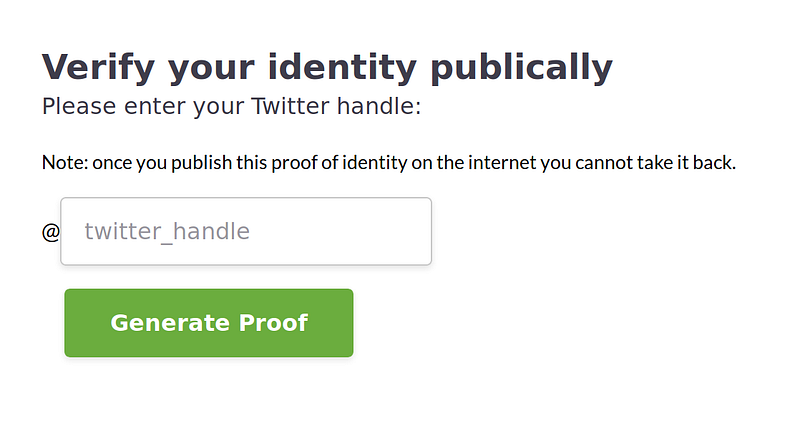Let the world know about your contributions
Jason Smythe
December 22, 2019 · 4 min read
Wildcards is excited to announce a new feature, cryptographically verifiable attestations of identity!
What exactly does this mean, in simple terms?
The owner of a wildcard can now have their twitter handle publicly displayed on our website showing they are the owner.
Go forth and show you believe in wildlife conservation!
How does this work?
Ethereum allows users to sign a message with their account. This signature is publicly verifiable to have only been signed by the owner of the account.
This is only half of the problem though, I could for example sign a message that says “I am the @realDonaldTrump” but that is rather meaningless, unless I post that from the correct twitter account (namely Donald Trump’s twitter account). That is exactly what we require from you, that you post the signed message from a twitter account that you own.
Step by step guide
To verify you own a Wildcard you need to own a wildcard first.
- Click on your wildcard to go to the detailed view (eg. https://wildcards.world/#details/andy).
- Click on the “Verify” button under your wildcard.

3. Enter your twitter handle.

4. Click generate proof, and wait for your Ethereum signer to open. Read the message you are signing and make sure it is correct, than click sign.

5. Copy the message and paste it in a tweet on twitter. Get the link of the tweet.
 And JasoonSmythe is the current patron the wildcard info page.
And JasoonSmythe is the current patron the wildcard info page.
Why this is important?
Your reputation is valuable. If you believe that people today or in the future will value and appreciate that you did a good deed of donating money to a wildlife conservation, then your contribution is an investment into your reputation. Dollars and Euros are not the only things that people value, thankfully.
It works the other way around too! Everyone has existing social capital, and validating your identity to owning a Wildcard imbues some of that social capital to the Wildcard. And this has the potential to make the wildcard more valuable, which thankfully isn’t a selfish thing — wildcards never stop generating funds for wildlife conservation.
Here is a concrete example from Wildcards history:
- On _Jun-27–2019 04:46:08 PM +UT_C Vitalik was born. He cost 0 ether — humble beginnings.
- Over the next day it was traded and the price was changed a number of times. It price fluctuated, and it changed hands: 0.0002 ETH, 0.4 ETH, …, 0.15 ETH, 0.25 ETH, 1.7 ETH. All this time Wildcards was generating money for wildlife conservation.
- And then, on the Jun-28–2019 09:31:46 AM +UTC, it was bought for 1.7 ETH and the price was set to 20ETH (3665.80 USD) by someone who clearly believes in our project.
Vitalik has a monthly pledge rate of 2.5% of its self assessed value. This means at its current price of 20ETH the owner pays 0.5 ETH (91.54 USD)per month to hold this token. This means that if someone buys Vitalik from them for 20ETH within 36.6 months they make a guaranteed profit. I would say that is a decent amount of incentive for someone to use their social capital to promote Wildcards and its case. And thus — the idea of Patronage Markets starts to come into reality.
As it happens, we do know who the owner of Vitalik is, and they have been public about it. But we hope to make this easier for other patrons on the Wildcards platform in the future.
We are constantly working on new features to further integrate the human and fun side of patronage markets via gamification, stay tuned as these new ideas are implemented.
Follow our socials to learn more about our project and the conservation causes we are working towards.
Follow us on Instagram: @wildcards_world
Follow us on Twitter: @wildcards_world
Follow us on Facebook: @wildcards.conservation
Join us on Discord
Dr Seahorse’s journey
From unravelling seahorses’ secret sounds to safeguarding the habitat of these little super dads. St...
Rio Button
June 29, 2022 · 5 min read
What wild animal leaves teddy bear footprints behind?
Photo by Helena Atkinson. Photo by Helena Atkinson. Here are some clues… Using their sticky tongues,...
Rio Button
February 07, 2022 · 9 min read
Tech innovation: Solving wildlife conservation's greatest challenge
Tech start-up Wildcards has raised over 130,000 USD for conservation organisations around the world ...
Rio Button
August 24, 2021 · 7 min read
Curious creatures under persecution
From having a deep fear of sharks to defending them. Reluctant, Grant Smith tumbled backwards off t...
Rio Button
July 26, 2021 · 8 min read
NFT Postcards for a purpose
NFT Postcards for a purpose A limited edition set of NFTs has been created in partnership with the T...
Jason Smythe
April 01, 2021 · 2 min read
Do you Care for Wild?
As rhino poaching soars, what happens to the orphaned rhino calves left behind? An orphaned baby bla...
Rio Button
February 24, 2021 · 7 min read
Where the wild things roam
South Africa’s most Endangered carnivore can’t be kept in by fences. Wildcards chatted to the man re...
Rio Button
February 23, 2021 · 10 min read
Rumours of an elusive feline in the mangrove forest
While collecting data in San Pedro de Vice Mangroves, in the Sechura desert, final year biology stud...
Rio Button
December 23, 2020 · 8 min read
South Africa’s last remaining white shark stronghold under threat
The Oceans Research Institute battles the impact of demersal longline fishing to safeguard great whi...
Rio Button
November 25, 2020 · 8 min read
Malaysia has marine mammals?
90% of Malaysians don’t know there are dolphins and whales in Malaysian waters There are at least 6 ...
Rio Button
November 17, 2020 · 9 min read
